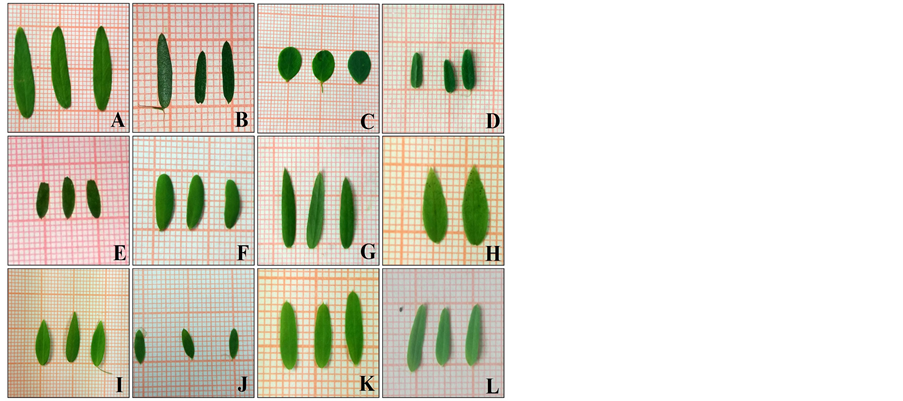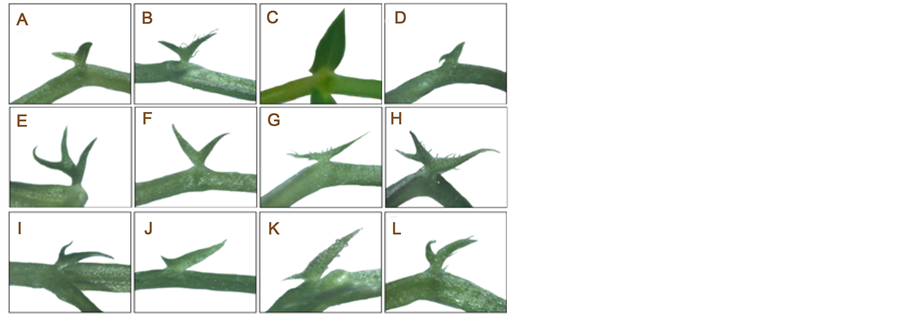Journal of Biosciences and Medicines
Vol.05 No.03(2017), Article ID:75156,6 pages
10.4236/jbm.2017.53018
Comparative Foliar Structure of Vicia L. Species from China
Ann Abozeid1,2, Yang Liu1, Jia Liu1, Zhonghua Tang1
1Key Laboratory of Plant Ecology, Northeast Forestry University, Harbin, China
2Botany Department, Faculty of Science, Menoufia University, Shebin El-koom, Egypt




Received: March 6, 2017; Accepted: March 31, 2017; Published: April 3, 2017
ABSTRACT
The genus Vicia L. includes about 190 species around the world and approximately 40 species in China. The genus includes minor food crops and forage plants. This study gives a detailed description of foliar structure of some Vicia species from China. Leaf characters showed considerable variation among studied taxa including petiole and tendril length; leaflets number, length, width, shape, apex, base; blade surface, trichome shape, type, base and length; stipules shape, base, length, width and surface. Numerical analysis of these characters was used to construct a phenogram illustrating the relationship between the studied taxa and to build an artificial key to identify Vicia species. Moreover, variation in leaf characters helped in overcoming the overlapping among harmful taxa.
Keywords:
Vicia, Fabaceae, Stipules, Trichomes, Numerical Taxonomy, Micro-Morphology

1. Introduction
Taxonomic significance of the foliar structure has been well documented [1] [2] [3]. Leaf micro-morphological characters show systematic significance in different levels in family Fabaceae [4] [5] [6]. Trichomes micro-morphology is one of the most significant leaf micro-morphological characters studied in species of different genera [7] [8].
The genus Vicia L. of the Fabaceae family includes about 190 species [9]. About 40 species have economic importance. The genus includes some minor food crops and more than a dozen forage plants; the most important is common vetch, V. sativa, cultivated in many countries [10].
Taxonomic delimitation is necessary to solve the overlapping between economic crops and harmful species. Morphological characters of leaf feature which may provides information for understanding species relationship in the genus Vicia, have not been studied. This work was initiated with the objectives of using leaf features to identify taxa.
2. Material and Methods
2.1. Seed Source and Morphological Examination
Vicia species seeds in this study were obtained from Desert Legume Program (DELEP) and The Germplasm Bank of Wild Species, Southwest China.
Seeds of each taxon were germinated in perlite sand; Ten days after germination (Seed were treated as germinated when the radical protruded from the envelopes), the young seedlings were transferred to pots containing peat moss soil. 60 days later, complete leaves were collected from each taxon, all the leaves were collected from the fifth nodes.
Stereo-microscope and light microscope were used for morphological measurement of the leaves.
2.2. Statistical Analysis
The extracted leaf characters were coded as 1 to 0 codes and used for numerical analysis; forty eight characters were recorded for each taxon. Phenogram illustrating the relationship between the studied taxa were constructed using the NTsys2.1 [11].
3. Results and Discussion
Considerable variation of leaf characters were observed among studied taxa as shown in Figures 1-3; for example, leaf consisted of 2 leaflets or 4 - 8 leaflets with their shape varying from elliptic, lanceolate, oblong, obovate to ovate. Leaflet apex was acute, acuminate, obtuse or truncate and the base was cuneate or obtuse. Leaf surface was hairy to glabrous. Stipules shape varied from sagittate to hastate with acute to forked base. Observed variations summarized in Table 1 and Table 2 enabled us to identify species.
Several natural systems had been constructed to divide the genus Vicia based on morphological characters such as stems, flowers, and fruits [12]-[17]. In addition to species identification, this work leaf characters were used to help in overcoming the overlapping among these systems.
In the natural system of [18], V. sativa subsp. nigra was treated as V. angustifolia subsp. pusilla; on the other side, [12] treated it as a subspecies of V. sativa; this suspicion may be dangerous as V. angustifolia is an important forage plant, belonging to the first group of fodder vetches [13], while V. sativa ssp. nigra is possibly contains gluco-alkaloids and neurotoxic cyanoamino acids which have toxic effect [19]. The phenogram in Figure 4 show that V. sativa subsp. nigra is more closely related to V. sativa (0.2 - 0.5 mm, acute, multicellular trichomes
Table 1. Leaf characters of studied species.
Table 2. Stipules structure of studied species.
with glandular base) and not to V. angustifolia (1 - 2 mm, linear, unicellular trichomes with non-glandular base) supporting the classification of [12].
An artificial key to Vicia species was constructed as follow:
Figure 1. Leaflets structure in studied Vicia species. (A) V. amoena; (B) V. angustifolia; (C) V. bungei; (D) V. costata; (E) V. hirsuta; (F) V. japonica; (G) V. sativa subsp. Nigra; (H) V. sativa subsp. Sativa; (I) V. tenuifolia; (J) V. tetrasperma; (K) V. villosa subsp. dasycarpa; (L) V. villosa subsp. varia.
Figure 2. Blade surface in studied Vicia species. (A) Smooth surface; (B) Glandular trichomes; (C) Non-glandular trichomes.
Figure 3. Stipules structure in studied Vicia species. (A) V. amoena; (B) V. angustifolia; (C) V. bungei; (D) V. costata; (E) V. hirsuta; (F) V. japonica; (G) V. sativa subsp. nigra; (H) V. sativa subsp. sativa; (I) V. tenuifolia; (J) V. tetrasperma; (K) V. villosa subsp. dasycarpa; (L) V. villosa subsp. varia.
Figure 4. Phenogram illustrating the relationships between the studied Vicia species on the bases of the micro morphological characters of the leaf, the total number of the recorded characters is (48) in each taxon.
1a. Leaflets obovate, V. bungei
1b. Leaflets elliptic (2)
2a. Blade with multicellular trichomes (3)
2b. Blade smooth or with unicellular trichomes (4)
3a. Leaflets ovate. Stipules base forked V. sativa subsp. sativa
3b. Leaflets lanceolate. Stipules base acute V. sativa subsp. nigra
4a. Leaflets blade hairy (5)
4b. Leaflets blade smooth (8)
5a. Leaflets oblong. Blade surface with linear trichomes (6)
5b. Leaflets lanceolate or ovate. Blade surface with acute trichomes (7)
6a. Blade with 0.1 to 0.5 mm distances between trichomes. Stipules with hairy surface V. angustifolia
6b. Blade with more than 2 mm distances between trichomes. Stipules with smooth surface V. villosa subsp. dasycarpa
7a. Leaf with 2 leaflets V. tenuifolia
7b. Leaf with 4-8 leaflets V. villosa subsp. varia
8a. Stipules with forked base V. hirsuta
8b. Stipules with acute base (9)
9a. Leaflets elliptic. Stipules hastate V. tetrasperma
9b. Leaflets lanceolate or oblong. Stipules sagittate (10)
10a. Leaflets with obtuse apex and cuneate base V. japonica
10b. Leaflets with acute or acuminate apex and obtuse base (11)
11a. Leaflets oblong V. costata
11b. Leaflets lanceolate V. amoena
In conclusion, our results show that leaf morphological characters are variable and helpful in distinguishing various species and could be used to construct an artificial key to identify Vicia species.
Acknowledgements
This study was supported by the National Natural Science foundation of China (Grant No. 31370007).
Cite this paper
Abozeid, A., Liu, Y., Liu, J. and Tang, Z.H. (2017) Comparative Foliar Structure of Vicia L. Species from China. Journal of Biosciences and Medicines, 5, 170-175. https://doi.org/10.4236/jbm.2017.53018
References
- 1. Ogundipe, O. and Kadiri, A. (2012) Comparative Foliar Epidermal Morphology of the West African Species of Amaranthaceae Juss. Feddes Repertorium, 123, 97-116. https://doi.org/10.1002/fedr.201100003
- 2. Fatihah, H.N.N., Nashriyah, M., Zai-mah, A.R.N., Khairil, M. and Ali, A.M. (2014) Leaf Morphology and Anatomy of 7 Varieties of Ficus deltoidea (moraceae). Turkish Journal of Botany, 38, 677-685. https://doi.org/10.3906/bot-1301-7
- 3. Trujillo-Moya, C., Peiro, R. and Gisbert, C. (2014) Leaf Morphology and Shoot Regeneration of in Vitro Cultured Explants from Species of the Solanum peruvianum sl Complex. Turkish Journal of Botany, 38, 465-476. https://doi.org/10.3906/bot-1305-16
- 4. Kadiri, A.B. and Olowokudejo, J.D. (2008) Comparative Foliar Epidermal Morphology of the West African Species of the Genus Afzelia smith (leguminosae: Caesalpinioideae) [estudio comparativo de la epidermis de la hoja de species del genero Afzelia smith (leguminosae: Caesalpinioideae) de africa occidental]. Gayana Botanica, 65, 84.
- 5. Ogundipe, O., Kadiri, A. and Adekanmbi, O. (2009) Foliar Epidermal Morphology of Some Nigerian Species of Senna (Caesalpiniaceae). Indian Journal of Science and Technology, 2, 5-9.
- 6. Mirzaei, L., Assadi, M., Nejadsatari, T. and Mehregan, I. (2015) Comparative Seed and Leaf Micromorphology of Colutea Species (fabaceae) from Iran. Environ Exp Biol, 13, 183-187.
- 7. Albert, S. and Sharma, B. (2013) Comparative Foliar Micromorpho-logical Studies of Some Bauhinia (Leguminosae) Species. Turkish Journal of Botany, 37, 276-281.
- 8. Grohar, M., Rosenfeldt, S. and Morales, M. (2016) Leaflet Tri-chome Micromorphology in the Dolentes-Brevipedes Taxonomic Complex (Mimosa l., Mimosoideae).Turkish Journal of Botany, 40, 45-58. https://doi.org/10.3906/bot-1412-40
- 9. Bisby, F., Zarrucchi, J., Schrire, B., Roskov, Y. and White, R. (1999) Ildis World Database of Legumes.
- 10. Hanelt, P. and Mettin, D. (1989) Biosystematics of the Genus Vicia L. (Leguminosae). Annual Review of Ecology and Systematics, 199-223. https://doi.org/10.1146/annurev.es.20.110189.001215
- 11. Rohlf, F. (2000) Ntsys-pc: Numerical Taxonomy (Vitis vinifera L.) Varieties Using Morphological Data and Multivariate Analysis System. Exeter Software, and Aflp Markers. Elect J Biotechnol, 6, 37-45.
- 12. Gunn, C.R. (1979) Genus Vicia, with Notes about Tribe Vicieae (Fabaceae) in Mexico and Central America. 1601, US Dept. of Agriculture, Science and Education Administration.
- 13. Komarov, V.L. (1972) Flora of the USSR. Vol. XIII. Leguminosae: Oxytropis, Hedysarum. Israel Program for Scientific Translations, Jerusalem.
- 14. Davis, P. (1970) Flora of Turkey. University Press, Edinburg, Vol. 3, 274-366.
- 15. Kupicha, F. (1976) The Infrageneric Structure of Vicia. Notes R Bot Gard Edinb, 34, 287-326.
- 16. Cui, H.B. (1998) Floras of China. Science Press, Beijing, Vol. 42, 232.
- 17. Leht, M. (2005) Cladistic and Phenetic Analyses of Relationships in Vicia Subgenus Cracca (Fabaceae) Based on Morphological Data. Taxon, 54, 1023-1032. https://doi.org/10.2307/25065486
- 18. Boissier, E. (1872) Flora orientalis. Genevae & Basileae, 2, 574-582.
- 19. Everist, S.L. (1974) Poisonous Plants of Australia. An-gus & Robert Son, Sydney.






